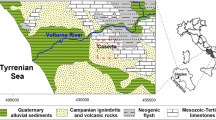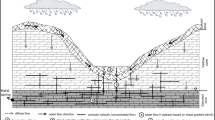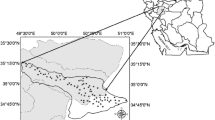Abstract
Specific vulnerability estimations for groundwater resources are usually geographic information system-based (GIS) methods that establish spatial qualitative indexes which determine the sensitivity to infiltration of surface contaminants, but with little validation of the working hypothesis. On the other hand, lumped parameter models, such as the Residence Time Distribution (RTD), are used to predict temporal water quality changes in drinking water supply, but the lumped parameters do not incorporate the spatial variability of the land cover and use. At the interface between these two approaches, a GIS tool was developed to estimate the lumped parameters from the vulnerability mapping dataset. In this method the temporal evolution of groundwater quality is linked to the vulnerability concept on the basis of equivalent lumped parameters that account for the spatially distributed hydrodynamic characteristics of the overall unsaturated and saturated flow nets feeding the drinking water supply. This vulnerability mapping method can be validated by field observations of water concentrations. A test for atrazine specific vulnerability of the Val d’Orléans karstic aquifer demonstrates the reliability of this approach for groundwater contamination assessment.




Similar content being viewed by others
References
Albéric P (2004) River back flooding into a karst resurgence (Loiret, France). J Hydrol 286:194–202
Aller L, Bennett T, Lehr JH, Petty RJ, Hackett G (1987) DRASTIC: a standardized system for evaluating groundwater pollution potential using hydrogeological settings. US Environmental Protection Agency, Washington DC, USA
Aris R (1959) On the dispersion of a solute by diffusion, convection and exchange between phases. Chem React Eng. doi:A252
Auterives C, Binet S, Albéric P (2014) Inferred conduit network geometry from geological evidences and water-head in a fluvio-karstic system (Val d’Orleans, France). Environ Earth Sci. doi:10.1007/978-3-319-06139-9_3
Bakalowicz M (2005) Karst groundwater: a challenge for new resources. Hydrogeol J. doi:10.1007/s10040-004-0402-9
Barry DA, Parker JC (1987) Approximations for solute transport through porous media with flow transverse to layering. Transp Porous Media 2:65–82
BDAT-GISSOL-INRA (2014). http://www.gissol.fr/programme/bdat/bdat.php. Accessed 10 Dec 2014
Beltman WHJ, Boesten JJTI, Van der Zee SEATM (1994) Analytical modelling of pesticide transport from the soil surface to a drinking water well. J Hydrol 169:209–228
Binet S, Motellica M, Touze S, Bru K, Klinka T (2015) Water and Acrylamide monomer transfer rates from a settling basin to groundwaters. Environ Sci Pollut Res 22:6431–6439
Brouyère S (2001) Modelling of dual porosity media: comparison of different techniques and evaluation on the impact on plume transport simulations. PhD Thesis Liège University
Charmoille A, Binet S, Bertrand C, Guglielmi Y, Mudry J (2009) Hydraulic interactions between fractures and bedding planes in a carbonate aquifer studied by means of experimentally induced water-table fluctuations Coaraze experimental site, southeastern France. Hydrogeol J 17:1607–1616
Chéry J (1983) Etude hydrochimique d’un aquifère karstique alimenté par perte de cours d’eau (La Loire): Le système des calcaires de Beauce sous le Val d’Orléans. PhD Thesis Orléans University
Desprez N (1967) Inventaire et étude hydrogéologique du Val d’Orléans. Rapport BRGM D-SGR-67-A21
Doerfliger N, Jeannin PY, Zwahlen F (1999) Water vulnerability assessment in karst environments: a new method of defining protection areas using a multi-attribute approach and GIS tools (EPIK method). Environ Geol 39:165–176
Escolero OA, Marin LE, Steinich B, Pacheco AJ, Cabrera SA, Alcocer J (2002) Development of a protection strategy of karst limestone aquifers: the Merida Yucatan, Mexico case study. Water Resour Manag 16:351–367
Fernandez GP, Chescheir GM, Skaggs RW, Amatya DM (2006) DRAINMOD – GIS: a lumped parameter watershed scale drainage and water quality model. Agric Water Manag. doi:10.1016/j.agwat.2005.03.004
Flury M (1996) Experimental evidence of transport of pesticides through field soils - a review. J Environ Qual 25:25–45
Footways/Géo-Hyd (2013) Application Phyto’Scope au Val d’Orléans: Outils d’évaluation du transfert des produits phytosanitaires de leurs zones d’application vers les eaux de surface et les eaux souterraines
Gelhar LW (1992) A critical review of data on field-scale dispersion in aquifers. Water Resour Res 7:1955–1974
Goldscheider N, Popescu C (2003) Vulnerability and risk mapping for the protection of carbonate (karst) aquifer. European commission Directorate - General for Research, pp 320
Goldscheider N, Hötzl H, Fries W, Jordan P (2001) Validation of a vulnerability map (EPIK) with tracer tests. 7th conference on limestone hydrology and fissured media. Sci Tech Environ Mém 13:167–170
Gutierrez A, Binet S (2010) La Loire souterraine: circulations karstiques dans le Val d’Orléans. Geosciences 12:42–53
Holman IP, Palmer RC, Bellamy PH, Hollis JM (2005) Validation of an intrinsic groundwater pollution vulnerability methodology using a national nitrate database. Hydrogeol J 13(5):665–674
IUPAC (2013) Global availability of information on agrochemicals. University of Hertfordshire. http://sitem.herts.ac.uk/aeru/footprint/es/Reports/43.htm . Accessed 10 Apr 2013
Jeannin PY, Cornaton, F, Zwahlen F, & Perrochet P (2001) VULK : a tool for intrinsic vulnerability assessment and validation. 7th conference on limestone. Hydrology and fissured media, Besançon. Sci Tech Envir Mém H S 13:185–190
Joigneaux E (2011) Etat qualitatif des eaux de la nappe du Val d’Orléans; Impact du changement climatique et gestion durable de la ressource. PhD Thesis Orléans University
Joigneaux E, Albéric P, Pauwels H, Pagé C, Terray L, Bruand A (2011) Impact of climate change on groundwater point discharge: back flooding of karstic springs (Loiret, France). Hydrol Earth Syst Sci 15:2459–2470
Joodi AS, Sizaret S, Binet S, Bruand A, Alberic P, Lepiller M (2009) Development of a Darcy-Brinkman model to simulate water flow and tracer transport in a heterogeneous karstic aquifer (Val d’Orléans, France). Hydrogeol J 18:295–309
Jurgens BC, Böhlke JK, Eberts SM (2012) Tracer LPM (Version 1): An Excel ® workbook for interpreting groundwater age distributions from environmental tracer data. US Geological Survey Techniques and Methods Report 4-F3, USA
Jury A (1982) Simulation of solute transport using a transfer function model. Water Resour Res 2:363–368
Kladivko EJ, Van Scoyoc GE, Monke EJ, Oates KM, Pask W (1991) Pesticide and nutrient movement into subsurface tile drains on a silt loam soil in Indiana. J Environ Qual 20:264–270
Kreft A, Zuber A (1978) On the physical meaning of the dispersion equation and its solutions for different initial and boundary conditions. Chem Eng Sci 33:1471–1480
Larsbo M, Jarvis N (2003) A model of water flow and solute transport in macroporous soil. Technical description. Studies in the biogeophysical environment, Swedish
Lasserre F, Razack M, Banton O (1999) A GIS-linked model for the assessment of nitrate contamination in groundwater. J Hydrol 224:81–90
Ledoux E (2003) Modèles mathématiques en hydrogéologie. Document du Centre d’Information Géologique Ecole Nationale Supérieur des Mines de Paris, Paris
Lelong F, Jojza N (2008) Fonctionnement du système karstique du Val d’Orléans: les acquis, les interrogations. CFH - Colloque hydrogéologie karst au travers des travaux de Michel Lepiller, Orléans
Lepiller M (2006) Le Val d’Orléans. Aquifère et eaux souterraines en France (BRGM), pp 200–214
Levenspiel O (1962) Chemical reaction engineering. New York
Li C, Ren L (2011) Estimation of unsaturated soil hydraulic parameters using the ensemble kalman filter. Vadose Zone J 10:1205–1227
Livrozet E (1984) Influence des apports de la Loire sur la qualité bactériologique et chimique de l’aquifère karstique du Val d’Orléans. PhD Thesis Orléans University
Maloszewski P, Zuber A (1982) Determining the turnover time of groundwater systems with the aid of environmental tracers – 1. Models and their applicability. J Hydrol 57:207–231
Martin JC, Noyer ML (2003) Caractérisation du risque d’inondation par remontée de nappe sur le Val d’Orléans. BRGM, Orléans
Molénat J, Davy P, Gascuel-Odoux C, Durand P (1999) Study of three subsurface hydrologic systems based on spectral and cross-spectral analysis of time series. J Hydrol 222:152–164
Nash JE, Sutcliffe JV (1970) River flow forecasting through conceptual models part I - a discussion of principles. J Hydrol 10:282–290
Neukum C, Hötzl H, Himmelsbach T (2008) Validation of vulnerability mapping methods by field investigations and numerical modelling. Hydrogeol J. doi:10.1007/s10040-007-0249-y
Panagopoulos GP, Antonakos AK, Lambrakis NJ (2006) Optimization of the DRASTIC method for groundwater vulnerability assessment via the use of simple statistical methods and GIS. Hydrogeol J 14:894–911
Plummer R, de Loë R, Armitage D (2012) A systematic review of water vulnerability assessment tools. Water Resour Manag 26:4327–4346
Sadek MA, Abd El-Samie SG (2001) Pollution vulnerability of the quaternary aquifer near Cairo, Egypt, as indicated by isotopes and hydrochemistry. Hydrogeol J. doi:10.1007/s100400100125
Schwientek P, Maloszewski P, Einsiedl F (2009) Effect of the unsaturated zone thickness on the distribution of water mean transit times in a porous aquifer. J Hydrol 373:516–526
Šimůnek J, Šejna M, Sakai M, Van Genuchten M Th. (2008) The HYDRUS-1D Software Package for Simulating the One-Dimensional Movement of Water, Heat, and Multiple Solutes in Variably-Saturated Media. Riverside, California
Srinivasan R, Arnold JG (1994) Integration of basin-scale water quality model with GIS. J Am Water Resour Assoc 30:453–462
Visser A, Dubus IG, Broes HP, Brouyère S, Korcz M, Orban P (2009) Comparison of methods for the detection and extrapolation of trends in groundwater quality. J Environ Monit 11:2030–2043
Voltz M, Louchart X (2001) Les facteurs clés de transfert des produits phytosanitaires vers les eaux de surface. Ingénieries - Phytosanitaires, pp 45–54
Vrba J, Zaporozec A (1994) Guidebook on mapping groundwater vulnerability. USA
Wauchope RD (1978) The pesticide content of surface water draining from agricultural fields. J Environ Qual 7:459–472
Zwahlen F et al. (2003) COST Action 620 - vulnerability and risk mapping for the protection of carbonate (karst) aquifers. Final report. European Cooperation in the field of scientific and technical research (COST Action 620)
Acknowledgments
This work is part of the PhD project supported by GEO-HYD (Antea members) and a national grant from the National Research and Technology Association (ANRT – CIFRE).
The database used was made available by the INSU/CNRS national observatory of karstic aquifers, SNO KARST.
Author information
Authors and Affiliations
Corresponding author
Rights and permissions
About this article
Cite this article
Dedewanou, M., Binet, S., Rouet, J.L. et al. Groundwater Vulnerability and Risk Mapping Based on Residence Time Distributions: Spatial Analysis for the Estimation of Lumped Parameters. Water Resour Manage 29, 5489–5504 (2015). https://doi.org/10.1007/s11269-015-1130-8
Received:
Accepted:
Published:
Issue Date:
DOI: https://doi.org/10.1007/s11269-015-1130-8




